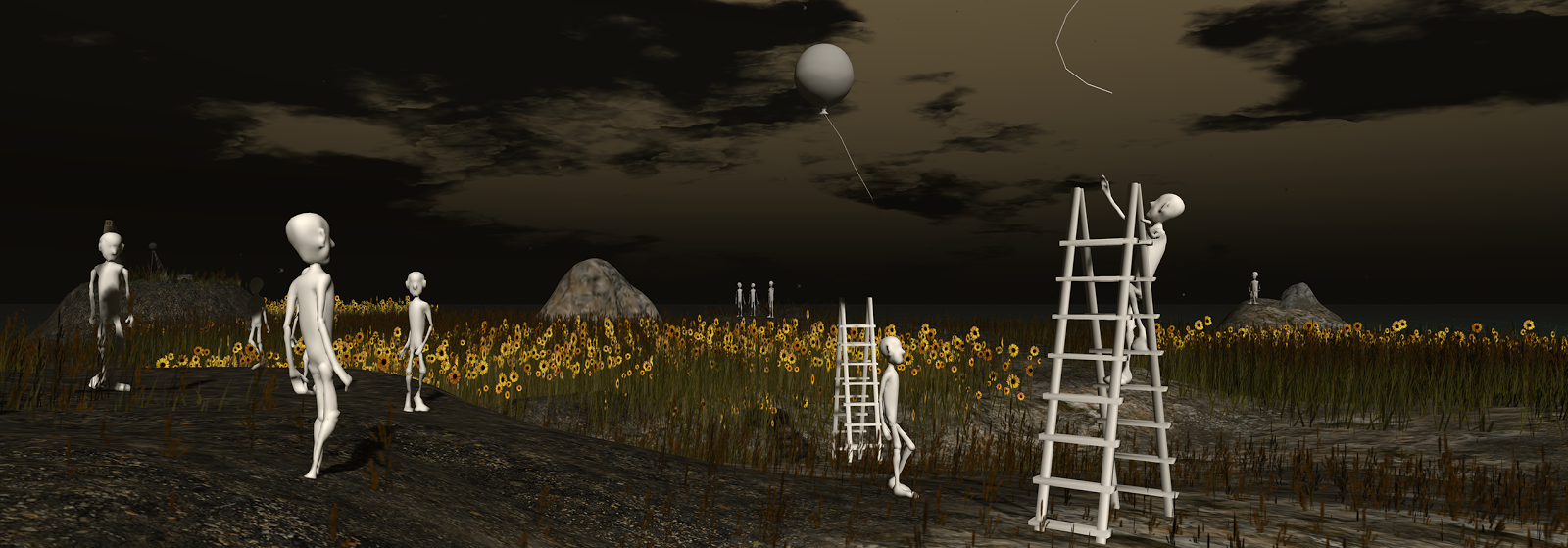Now open at Immersiva is
Lobby Cam, an expansive and immersive new installation by Bryn Oh. Consistent with Bryn's previous works,
Lobby Cam presents viewers with a disturbing psychological (and very human) situation, but this time directly invites visitors to creatively participate to complete the experience. "I like the idea of the guest here getting to be an active part of the story," Bryn told me, "and having to try to place themselves in a tricky spot to defend."

The setting itself is beautiful: a Saskatchewan wheat field that blows in the gentle wind, a languidly turning windmill, and a tall grain elevator positioned at railroad tracks that cut across the farm. We spot an abandoned pickup truck and streetcar, and signs of habitation in the buildings. The windmill, the wheat and the pages all blow in the SL wind, as do the tree pollen particles. It's mesmerizing to stand in the field, or to sit on the nearby train station bench, watching the wheat sway and watching the sun break through the clouds, illuminating patches of grain before retreating. (Second Life, by the way, really does have wind, and if you'd like to learn more,
visit the Wiki, although it may be out of date.)

But as captivating as the wheat field and environs are, they're the backdrop to a larger story, and to focus solely on the build would be to miss the point. You, as the visitor, are given a task as you arrive: scattered around and throughout the field, the buildings and spaces are the tattered and torn pages of a diary, some of them drifting in the wind. (There are eddies in the wind to keep the pages from wandering too far.) As you collect the pages, the diary begins to take form, and a story — that of a lobby security camera and its impact on the lives of two people, both isolated in their own ways and geographically separated by a long distance — unfolds. After you've completed reassembling the diary — along with finding a stamp, an envelope, paper and an address — it's your turn to create: you need to write a letter, as the protagonist in the story, and it presents a most awkward situation. It's a "near impossible task," Bryn says, in which you have to explain yourself in a most cautiously delicate way (unless, of course, you choose otherwise). After mailing your letter, you'll receive a reply. And the visitor really can't get the essence of the artwork without completing this task. [Note: Some letters sent on the first couple days of the build were lost because of a glitch, so if you didn't receive a reply, try again.]

Now, there are some nuts and bolts things you need to know to make the experience work. First, you'll see as you arrive that you need to obtain a HUD, which is free. Wear and then unwear it, and then wear it again. (For some reason, that will prevent the HUD from losing information.) You can click on the large icon in the upper right to minimize the HUD. As you collect pages, the HUD, which shows the diary, will fill with them (click on the diary pages themselves to move backward and forward, not on the arrows), and you'll also see the stamp, ink, envelope, paper and address on the right side light up as you obtain them. Be sure to have media enabled to auto-play, and be sure to have your local sounds turned up — there are things to hear. I remarked to Bryn at one moment that I heard thunder, and she replied, "There are a dozen sounds all working together, a plane too at one point." The parcel's native windlight is strongly recommended. And please consider leaving a contribution in support of Immersiva at the landing point.

Bryn and I got to talking about distinction between "real" and virtual artwork as we sat on the bench at the train station, watching the wheat sway and people search for diary pages. I asked her if she had considered exhibiting images from her virtual works in a real life gallery setting, much as Lobby Cam conversely shows some of her real life art. "For me," she said, "this build right here is the artwork: the people from around the world mingling, the open ended nature and freedom, the duration and interaction. We are not passive observers, and in the end the viewers are the main character."

Lastly, don't read this paragraph if you're concerned about spoilers, although I'm not giving away much. The diary pages, if you look at their names, are all species or subspecies of wheat. And your letter to Fern isn't going to get a canned response — the replies are all individual, based on the tone you deliver. "She replies fairly accurately," said Bryn: if you're a total creep, you might well receive a restraining order. "And then there are ones where she invites him to show at her gallery in Toronto," commented Bryn on the more positive replies, "which is that front room [in the lobby near the arrival point], and the painting of the scene that breaks open is his work, so there is the idea that they do meet." As I asked Bryn whether these characters were based on anyone she knew, she replied, "Everything I make here is based on me, from Anna to the Rabbicorn to Kumiko [from earlier installations]. But the idea is also a macro one of Second Life: how we meet others and project onto them. He watches Fern and images who she is, but he really has no idea who she is. She is who he wants her to be, and the dream is that she is that person."




















































